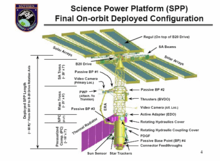Science Power Platform
The Science Power Platform (SPP) ( Russian: Научно-энергетическая платформа , abbreviated to НЭП , German NEP) was a planned Russian energy control module for the International Space Station (ISS). It was to be brought to the station by the US space shuttle (planned with STS-138 ) and assembled there.
The main task of the module would have been to provide additional energy for the ISS. In addition, it should have control nozzles with which a roll of the space station around its longitudinal axis could have been corrected. The SPP should be serviced with the help of the European robotic arm .
The module was originally designed for the Mir-2, the successor to the Mir station, and was to be brought into space with a Zenit rocket .
Plans published by the Russian Space Agency in 2004 were based on the expansion of the Science Power Platform into a fully-fledged module (Russian: Научно-энергетический модуль , abbreviated НЭМ , German NEM) with a pressurized space and a laterally arranged coupling nozzle . The Pirs module was to be attached to the NEM later.
After the construction plan of the space station adopted on March 2, 2006, the SPP was canceled. Instead, after the expansion of the ISS, the Russian part of the station receives energy from the large solar modules in the American part of the station. This eliminated the need for Russia to build its own energy module and transport it to the ISS. The already completed hull of the SPP was used to build the Russian module Rassvet .

